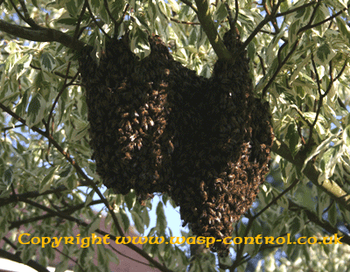Bee Life Cycle
Information on the Life Cycle of Honey, Bumble and Masonry Bees
Honey Bee Life Cycle
Honey bees remain active throughout the entire year, eschewing hibernation unlike some other bee species.
During the summer, honey bees diligently collect nectar from various sources such as plants, trees, and flowers. They subsequently reduce the water content of the nectar, transforming it into honey, which serves as their primary food source. Any excess honey is stored for consumption during the winter months.
The honey bee community comprises three distinct types:
- Queen: Typically, there is only one queen in a healthy colony. The queen is responsible for laying eggs under normal circumstances.
- Workers: These sterile females constitute the majority of the colony. They diligently carry out daily tasks, including collecting nectar, pollen, and water, caring for the brood, and constructing honeycombs.
- Drones: These are males with the sole purpose of mating with new queens. Interestingly, drones lack a stinger.
Development stages of honey bee eggs are as follows:
- Queens: 3 days as an egg, 5 days as larvae, 8 days as pupae, totaling 16 days of development before hatching as an adult with a lifespan of 4 years.
- Workers: 3 days as an egg, 6 days as larvae, 12 days as pupae, totaling 21 days of development before hatching as an adult with a lifespan of 6 weeks.
- Drones: 3 days as an egg, 7 days as larvae, 14 days as pupae, totaling 24 days of development before hatching as an adult with a lifespan of 3 months.
Note: These timeframes may vary.
Reproduction in honey bees is intricate. When a colony outgrows its current nest, worker bees construct special cells for creating new queens. The original queen departs with approximately half of the bees in a process known as swarming. After leaving the nest, the swarm typically clusters on a branch, dispatching scout bees to find a new home. Once a suitable location is discovered, the clustered bees take flight en masse to their new abode.
Back in the old nest, the newly hatched queens emerge. Typically, the first queen to hatch seeks out other queens still in their cells, stinging them to death. The victorious queen assumes control of the colony and mates with drone bees.
Occasionally, more than one queen hatches, leading to smaller swarms leaving the nest, known as cast swarms. Queens in cast swarms are unmated.

Bumblebee Life Cycle
Bumblebees follow a distinct life cycle that differs from honey bees. During the winter months, a queen bumblebee enters a state of hibernation, and unlike honey bees, they do not store honey for sustenance. Typically, queen bumblebees hibernate in the ground.
As the temperature rises in spring, the queens emerge from their winter dormancy, seeking nourishment from nectar-producing flowers.
The queens actively search for a suitable nesting site, often revisiting the same areas year after year. Once the nest site is chosen, the queen creates a beeswax honey pot, which she fills with a small amount of honey. Unlike honey bees, bumblebees do not produce enough honey for harvest.
Pollen is also stored in the nest as a reserve for the queen during challenging weather conditions. The queen lays a modest number of eggs on a pollen ball and diligently keeps the eggs warm for an incubation period of around four days. Young bumble bees are nourished with pollen.
Various bumblebee species exhibit different pupation times. When the young larvae are prepared to pupate into adults, they spin a silk cocoon, transforming into adult bees.
In summer, new queens and drones are produced periodically. The male drones congregate around a nest when a new queen is ready to emerge. Following the mating process, the succesful drones pass away, and the queen eventually enters a hibernation phase during the winter, preparing for the upcoming year.
Mason Bee Life Cycle
In contrast to honey bees and bumblebees, Mason bees are solitary insects, meaning they do not produce honey or wax.
The life cycle of Mason bees begins in spring when they emerge from their cocoons. Males are the first to appear, and upon the emergence of females, mating takes place, after which the males perish.
These solitary bees exhibit a preference for nesting in small tube-like holes, often found in plastic weep vents and window surrounds, commonly mistaken for wasps in brickwork.
Females diligently collect nectar and pollen to provision their offspring. The nesting process involves the female packing mud into the hole, followed by layers of nectar, pollen, and the placement of an egg. This sequence is repeated until the hole is fully occupied, with male eggs strategically laid last in the tube, ensuring their emergence first. Once the hole is filled, the female seals it with mud.
By midsummer, the larvae have consumed all the provisions supplied by their mother and are prepared to spin a cocoon, marking the beginning of their pupation into adult bees.
There is no need to have Mason or Mining bees exterminated. They are harmless benificial insects.
Mining Bee Life Cycle
Mining bees have a similar life-cycle to Mason Bees, except they burrow into the ground to lay their eggs. They are a solitary bee.